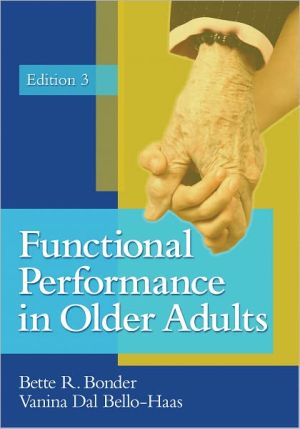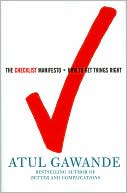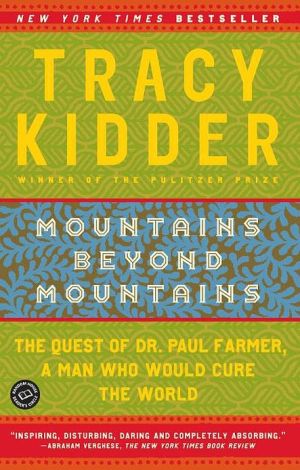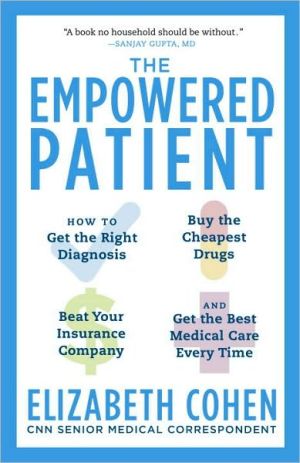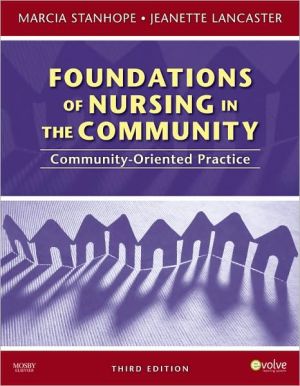Functional Performance in Older Adults
The contributors represent diverse disciplines, however their messages create a coherent, integrated work of universal interest and application. I highly recommend the use of this text for allied health students who are studying geriatric rehabilitati\ \ This book contains black-and-white illustrations.\
Search in google:
The contributors represent diverse disciplines, however their messages create a coherent, integrated work of universal interest and application. I highly recommend the use of this text for allied health students who are studying geriatric rehabilitation and for clinicians who wish to renew their knowledge. Carole Knight, MEd, OTR/L, Occupational Therapy in Health Care Journal, Volume 16, Number 2/3 February 2003, review of the 2nd Edition. The ideal resource for rehabilitation professionals who are working with or preparing to work with older adults! It describes the normal aging process, illustrates how health and social factors can impede an aging person abilities, and demonstrates how to develop mechanisms for maximizing the well-being of older adults. Laurie Rockwell-Dylla Part 1 of this book describes the normal aging process in terms of the ""experience"" of growing old as well as the ""components"" of a performance (e.g., sensory, cognitive) that are compromised in normal aging. The second part describes factors that contribute to dysfunction in older adults and discusses intervention strategies to maintain and improve functional performance of older individuals. The book provides an understanding of ""what it is that older individuals want to do, need to do, what facilitates accomplishment of those tasks and what interferes."" This is accomplished by providing insight into the needs of older adults and their families and discussion of intervention that is effective and meaningful. Although written for health care providers, allied health care students and clinicians, particularly in the fields of occupational therapy, physical therapy, and recreational therapy, will find it most useful. The authors and multidisciplinary contributors are credible authorities in the subject of aging and function. Several tables, figures, and photographs of adequate quality illustrate and clarify text in each chapter. Extensive references provide resources that are pertinent and timely. A unique feature is the inclusion of introductory quotations that are insightful and relevant to each chapter. A list of objectives and review questions for each chapter and a glossary are extremely useful. Case examples are another means of translating theoretical concepts into real-world application. This book offers a blending of theoretical concepts, practical assessment, and intervention strategies for improving the functional performance and quality of life of older individuals andtheir families. Although chapters are introductory in nature, experienced clinicians in geriatric practice would benefit from this resource. Given the textbook format of this publication, students and faculty would especially benefit from its use in undergraduate gerontology courses, especially in the field of occupational therapy.
Introduction xxix PART I. NORMAL AGING 1 SECTION 1. INTRODUCTION AND OVERVIEW 51. Growing Old in the United StatesBette R. Bonder 7Historical Definitions of Aging9Current Definitions11 Current Attitudes 11 Cultural Factors 12 Place of Residence 19Gender20 Individual History 21 Public Policy and Aging 21 Summary and Implications for Service Providers 222. Biological Theories of Aging: Implications for Functional PerformanceWojtek J. Chodzko-Zajko 28Definitions of Aging29 Biological Theories of Aging 31The Structural and Functional Consequences of Aging33 Individual Differences and Aging 34 Lifestyle Interventions and Aging 37 Conclusion 393. The Psychosocial Meaning of ActivityBette R. Bonder 42 Defining Meaning 44 Developing Meaning 44 Meaning of Activities; Theories 46Toward and Integrated Model51 Implications for Health-Care Providers 55 SECTION 2. THE AGING PROCESS 594. MobilityMarilyn B. Wagner and Timothy L. Kauffman 61Muscle Strength and Aging62The Skeletal System in the Older Adult70 Balance, Coordination, and Movement and Aging 71 Summary 80Appendix 4-1: Exercise for Persons 55 Years Old and Older85 5. Cardiopulmonary DevelopmentElizabeth Dean 86 Age-Related Anatomic Changes in the CardiopulmonarySystem and Its Function 89 Age-Related Changes in the Cardiovascular System and Its Function 90 Other Factors that Affect Cardiopulmonary and Cardiovascular Function 92 Functional Consequences of Age-Related Cardiopulmonary and Cardiovascular Changes 96 Functional Consequences of Fitness in Older People 105 Implications for the Management of the Care of Older People 108 Customizing the Environment to Maximize Function 115 Summary 115 6. Sensory and Sensory Integrative DevelopmentCelia Routh Hooper 121 Vision and Functional Performance 123 Hearing and Functional Performance 126 Taste and Smell: Physical Changes and Functional Performance 131 Somesthesis and Touch; Physical Changes and Functional Performance 132 Sensory Intergration: A conclusion 132 Appendix 6-1 137 7. Cognitive DevelopmentKathryn Perez Riley 138 Cognitive Changes in Normal Aging 139 Other Cognitive Abilities 141 Congnition and Activities in Normal Aging 144 Future Directions 149 SECTION 3. ACTIVITIES OF OLDER ADULTS 153 8. Self-CareCharles H. Christiansen and Cindy Lynn Hammecker 155 Defining Self-Care 156 Person-Environment and Enablement Models 156 Importance of Self-Care 156 Functional Limitations Influencing the Performance of Self-Care 161 Measuring Self-Care Performance 163 Prevalence and Type of Limitations of Activities of Daily Living Among Elderly Persons 167 Activity of Daily Living Intervention 168 Summary 175 9. Work and RetirementHarvey L. Sterns, M. Patricia Junkins and Janet G. Bayer 179 The Older Labor Force 180 Wellness Programs for Older Adults 183 Older Worker Performance 184 Obsolescence Versus Maintaining Competence 184 Retirement 189 Conclusion 192 10. LeisureAnita C. Bundy 196 Leisure and Aging 198 Leisure as a Statement of Identity 200 Elements of Leisure 201 A Tentative Model 210 Promotion of Leisure: Application of the Model 211 Summary 214 11. Sexuality in Late AdulthoodAndrew W. Miracle and Tina S. Miracle 218 Sex and the Elderly Population 219 Age-Related Physical Changes and Sexual Functioning 224 Effects of Disease on Sexuality 227 Other Factors Affecting Sexuality 228 Summary and Implications for Health Professionals 230 Appendix 11-1: How to Obtain Additional Information 235 12. Assessment of Functional PerformanceSeanne Wilkins, Mary Law and Lori Letts 236 The Meaning of Assessment 237 Assessment Philosophy 239 Assesment Realities 241 A Conceptual Framework for Assessment of Performance 242 A Decision-Making Process to Guide Assessment 244 Issues in the Assessment of Performance with Older Adults 244 Assessment Methods 248 Summary 250 Assessment Examples 251 PART II. INTERRUPTIONS IN FUNCTIONAL PERFORMANCE 257 SECTION 4. FACTORS CONTRIBUTING TO DYSFUNCTION IN OLDER ADULTS 265 13. FallsRein Tideiksaar 267 Epidemiology 268 Causes of Falling 270 Clinical Assessment and Intervention 273 Interventions 278 Common Environmental Hazards 278 Fear of Falling 279 Alternatives to Physical Restraints 280 Intervention Trials 281 Summary 284 14. DementiaMary A. Corcoran 287 Irreversible Conditions Resulting in Dementia 289 The Notion of Excess Disability 290 Assessing Functional Performance in Individuals with Dementia 293 Managing Dementia-It takes a Team 296 Summary and Future Directions 302 15. DepressionKathryn Perez Riley 305 Overview of Depressive Disorders in Older Adults 306 Depression and Functional Status: An Interactive Relationship 310 Treatment of Depression 313 Cultural Factors in Depression 315 Summary and Future Directions 315 SECTION 5. INTERVENTION STRATEGIES 319 16. WellnessBette R. Bonder 321 Defining Wellness 322 Factors That Promote Wellness 323 Theories of Behavior Change 330 Designing and Funding Programming 332 Model Programs 336 Conclusion 336 17. Community-Based ServicesGeorgia J. Anetzberger 339 Service Classifications 340 Service Utilization 341 Something to Do 344 Someone to Care 353 Someplace to Live 355 Summary and Future Directions 358 18. Home Health CareBen J. Atchison 363 Historical Development of Home Health Care 364 Cost-Effectiveness of Home Care 365 Qualifications for the Medicare Home Health Benefit 366 Common Conditions Treated in Home Care 367 Age and Functional Status of Home-Care Clients 367 Caregiver Issues 368 Core Competencies of Occupational Therapy Practice in Home Health Care 368 The Therpeutic Process in Home Health Care 372 Conclusion 378 Appendix 18-1: Home Health Care 382 19. RehabilitationLynnda J. Emery 390 Geriatric Rehabilitation Priorities 391 Evaluation in Geriatric Rehabilitation 391 Factors to Consider in Treatment of Older Persons 394 Conditions Frequently Treated In Rehabilitation 396 Common Problems of Older Adults 398 Rehabilitation Delivery Systems for Older Persons 399 Reimbursement and Practice Management 400 Summary 403 20. Activities as Agents for Intervention and Rehabilitation in Long-Term CareRuth E. Plautz and Cameron J. Camp 405 Evolution of the "Modern" Nursing Home 406 OBRA '87 Philosophy and Occupational Therapy 408 Activities in Long-Term Care 411 Interdisciplinary Teams in Long-Term Care 412 Therapies and Total Environment 414 Regulatory and Reimbursement Issues 415 Innovative Trends 415 Summary and Challenges 420 Appendix 20-1: Coding Sheet for Montessori Activities 423 SECTION 6. SPECIAL TOPICS 427 21. TechnologyWilliam C. Mann 429 Definitions and Concepts 430 Aging and Functional Performance 431 Assistive Technology for Older Adults 432 Disability Impact Continuum: Difference in Assistive Technology Needs 441 Appendix 21-1: Resources 447 22. Driving and Older AdultsBeth A. Ekelman, Steven Mitchell and Pam 0'Dell-Rossi 448 Overview of National Statistics on Violations, Crashes, and Fatalities 449 Neurosensory Model of Driving 449 Age-Related Physiological and Disease-Related Changes Affecting Driving Performance 455 Clinical Assessment and Intervention 459 Suggestions for the Geriatric Clinician 470 Losing the Ability to Drive-A Psychosocial Perspective 471 Conclusions 474 Appendix 22-1: Occupational Therapy Driving Evaluation 478 23. Families and Professionals: Therapeutic ConsiderationsBette R. Bonder and Betty R. Hasselkus 487 Factors Affecting Family Relationships 489 Therapeutic Relationshops 490 Techniques for Practice 493 Addressing Family Issues in the Current Health-Care Environment 496 Summary 497 24. The End of LifeRosalind A. Bye, Gwynnyth M. Llewellyn and Karl E. Christl 500 Understanding Terminal Illness 501 Individuals' Experience of Terminal Illness 502 Terminal Illness and the Older Person 503 A Good Death 504 Palliative Care 504 Occupational Therapy and Physical Therapy-Our Role in Palliative Care 506 Reframing Occupational Therapy and Physical Therapy for Palliative Care 507 Therapy That Affirms Life and Helps Prepare for Death 508 Reframing the Processes of Therapy 509 Support Strategies for Therapists 516 Conclusions 518 Glossary 521 Index 533
\ Laurie Rockwell-DyllaPart 1 of this book describes the normal aging process in terms of the ""experience"" of growing old as well as the ""components"" of a performance (e.g., sensory, cognitive) that are compromised in normal aging. The second part describes factors that contribute to dysfunction in older adults and discusses intervention strategies to maintain and improve functional performance of older individuals. The book provides an understanding of ""what it is that older individuals want to do, need to do, what facilitates accomplishment of those tasks and what interferes."" This is accomplished by providing insight into the needs of older adults and their families and discussion of intervention that is effective and meaningful. Although written for health care providers, allied health care students and clinicians, particularly in the fields of occupational therapy, physical therapy, and recreational therapy, will find it most useful. The authors and multidisciplinary contributors are credible authorities in the subject of aging and function. Several tables, figures, and photographs of adequate quality illustrate and clarify text in each chapter. Extensive references provide resources that are pertinent and timely. A unique feature is the inclusion of introductory quotations that are insightful and relevant to each chapter. A list of objectives and review questions for each chapter and a glossary are extremely useful. Case examples are another means of translating theoretical concepts into real-world application. This book offers a blending of theoretical concepts, practical assessment, and intervention strategies for improving the functional performance and quality of life of older individuals andtheir families. Although chapters are introductory in nature, experienced clinicians in geriatric practice would benefit from this resource. Given the textbook format of this publication, students and faculty would especially benefit from its use in undergraduate gerontology courses, especially in the field of occupational therapy.\ \ \ \ \ Reviewer:Amy J. Kratz, OTR/L (Creighton University) \ Description:This book provides a current look at aging and its influence on an individual's ability to engage in activities of importance. This edition includes an expansion of several chapters from the previous 1994 edition and chapters on such issues as community-based care, theories on aging, wellness, sexuality, and driving.\ Purpose:The purpose is to educate occupational therapists, physical therapists, and students about aging and its impact on functional performance and quality of life. Authors meet this purpose through inclusion of chapters related to normal aging as well as those related to specific interruptions in functional performance.\ Audience:Students and professionals wishing to enhance their knowledge and increase skills for working with the elder population will enjoy reading this book. Thirty-three individuals from the fields of occupational therapy, physical therapy, social work, speech-language pathology, and gerontology pool their expertise to inform healthcare professionals about the aging process and possible interventions. The extensive experience of authors working with the elder population enhances the depth and breadth of content covered in this book.\ Features:Experts in geriatrics discuss 24 different topics of importance to this population. The book begins by familiarizing the reader with effects of normal aging on activities of the older adult. The second part of the book focuses on dysfunction and intervention concluding with how therapists deal with end of life issues. Chapters include helpful tables and diagrams as well as case studiesand review questions to aid the reader in understanding content.\ Assessment:The focus on function and activity of the older adult throughout this hook makes this a valuable resource for geriatric practitioners. With this second edition, readers receive the latest information and intervention strategies for working with the older adult. Information difficult to address with the elderly population such as sexuality and driving make this book an important resource for those working with older adults.\ \ \ BooknewsThe health-care industry is showing a growing interest in people's abilities to do everyday activities in their daily lives; research shows that older adults who can accomplish meaningful activities are relatively satisfied with their lives, regardless of their objective health. For these reasons, the work of therapists, social workers, psychologists, and other professionals whose focus is on quality of life has gained increasing importance. The editors (health sciences, Cleveland State U.) selected contributors from the US, Canada, and Australia who represent a variety of perspectives on the aging process, activities of older adults, factors contributing to dysfunction, intervention strategies, and special topics such as technology, driving, and the end of life. Chapters new to this edition include theories of aging, sexuality, wellness, and community-based care. Annotation c. Book News, Inc., Portland, OR (booknews.com)\ \ \ \ \ 3 Stars from Doody\ \
